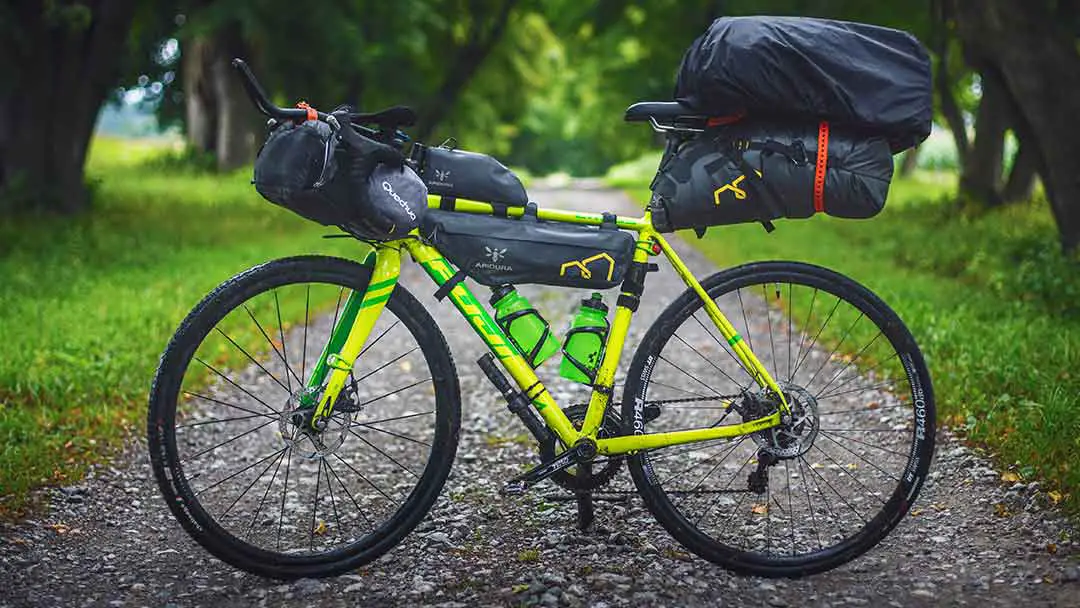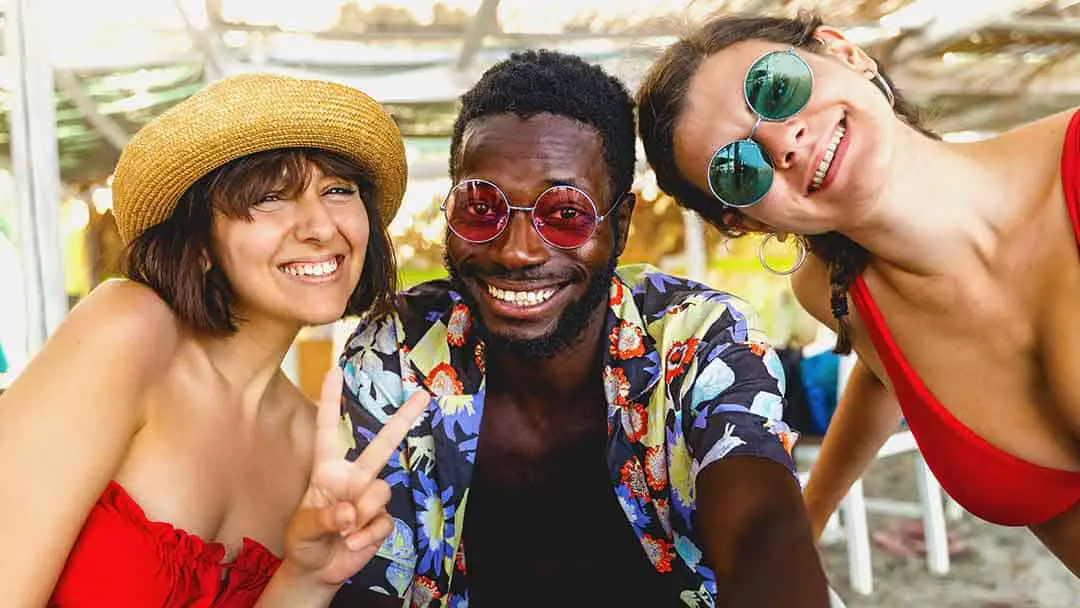Complete Bike Touring Cooking Guide

As an Amazon Associate we earn from qualifying purchases made on our website. If you make a purchase through links from this website, we may get a small share of the sale from Amazon and other similar affiliate programs. You can read our complete legal information for more details. By using this site, you agree the information contained here is for informational purposes only. For specific medical questions, consult your doctor. NO information on this site should be used to diagnose, treat, prevent or cure any disease or condition.
My uncle used to love cooking over the campfire. He was skilled at it and could make us all kinds of steak, baked apples, and other goodies. But what are the best foods to bring on a long bike tour?
The food you bring on your bike tour should be rich in nutrients and calorically dense. You want to save space on your bike while nourishing your body with the energy it needs for the day. The best foods include protein-rich snacks such as nuts, meat, and vegetables.
Should you start your day with a large, hearty breakfast? What should you eat during the day? Keep reading to find out more!
What Food Should You Bring on a Long Distance Bike Tour?
Long-distance bike touring requires a steady flow of nutrients throughout the day. It would help if you avoided large, carb-heavy meals with substantial added sugars and chemicals.
Not only are these substances bad for your health, but they’ll also bind up your digestion, possibly causing intestinal discomfort.
Despite what you might assume, large meals are not good for cycle touring. Large meals can weigh you down, slow your progress, and require long digestion periods.
Rather, you should bring foods that provide a hefty dose of nutrition in small quantities. According to MedLine Plus, these foods should be rich in protein, iron, and micronutrients. These nutrients build muscle, promote blood flow, and enhance overall health.
Meanwhile, substances such as sugar are not conducive to a healthy and active lifestyle. Sugar can appear in a wide variety of foods, including:
- Soda
- Juices
- Fruits
- Milk products
- Processed granola
- Processed snacks
Heavily processed, bleached white sugar is the worst kind of sugar.
Yet, not all sugars are created equal, thanks to the presence of antioxidants and fiber, such as are found in berries and fructose from fruits. These foods aren’t the best choice for cycle touring for the following reasons:
- Quickly burned calories
- Require large quantities to satiate
- Don’t store well on a bike
In detail below, we’ll dive into some of the best foods for your next cycling tour!

Beef
Beef is rich in vital nutrients for athletes, such as runners and bikers. It’s rich in vitamins and minerals, including essential nutrients such as protein, iron, and fat.
A single serving of beef (3oz cooked) contains 25 grams of protein, amino acids, and 1-2 milligrams of iron. These nutrients are the critical building blocks to sustain energy while cycling.
Almost every bike trip I go on includes some form of beef. I go heavy with the jerky too, but sugar-free and additive jerky from Carnivore Crisps. They also offer our readers a 10% discount with this link or use WILD at checkout.
Pork
Pork gets a bad wrap due to the presence of saturated fat. However, pork has several vital nutrients, and when eaten by active people, it can fuel your exercise!
Pork is rich in protein, iron, and monounsaturated fat. Pork is among the most nutritious foods thanks to its rich proteins, micronutrients, and healthy fats.
Despite being initially ranked as a poor heart health choice, pork is one of the better meats for your heart. According to Heart.org, monounsaturated fats are heart-healthy fats that actually help lower cholesterol and boost blood flow!
As a choice for biking, pork is a must-have!
Fish
Fish are one of the best sources of lean protein for athletic people. Fish is rich in zinc, calcium, and vitamins A and C.
This makes it ideal for workout recovery and muscle building. Fish has 16-22 grams of protein per serving and 12 grams of fat.
Finally, fish is one of the best sources of Omega-2 fatty acids. These fatty acids are essential building blocks of cells and are incremental to health and mental clarity!
I’ve regularly brought a can or two of tuna or smoked salmon on bike trips.
Chicken
Chicken is a decent source of nutrient-dense meat (beef is way better). While fat isn’t necessarily bad for you, getting a blend of high-fat and low-fat protein sources in your daily diet is good.
Chicken is an excellent source of collagen. Collagen is a type of protein that’s essential to cell rejuvenation and bone density.
Turkey
Turkey is similar to chicken in terms of nutrients and fat content. It’s slightly richer in iron and protein, making it a great way to diversify your diet.
It’s also one of the best sources of B vitamins. Turkey contains large quantities of B6, B3, and B12.
Vitamin B12 is vital for active people since it helps maintain a healthy heart and mind. B12 is essential for proper blood flow to the brain and helps prevent strokes and other issues.
Carbohydrates
While your leading food group on a bike tour will be protein, it’s important to diversify your diet. Carbohydrates are essential for maintaining energy and good blood glucose levels.
The types of carbohydrates are just as important, however. You won’t want to bring pretzels or white bread to make yourself feel full.
If you want to add carbohydrates to your meals, you may want to try these out:
- Cassava root
- Turnips
- Sweet Potatoes
- Plantains
- Winter squash
These vegetables should be eaten in moderate quantities. When you cook your meal, make these nutrient-rich foods rather than pasta, rice, or other starchy, processed foods.
Most of these vegetables can be kept at room temperature for several days without spoiling.
I know we are talking food but perhaps you are ready to plan your next trip? Here are some helpful guides:
- Cycle Touring in Ireland (The Ultimate Guide)
- 11 Best California Bikepacking Routes
- Guide to Bike Tours for Seniors (How to find)

How Much Food Should You Bring on a Long-Distance Bike Tour?
Most touring enthusiasts advise riders to bring enough food to satiate them for 36 hours.
Most riders require between 120-350 calories per hour (depending on their weight and energy output). You may need more per hour biking through a mountainous region.
While you don’t want to stop every hour for a snack, you’ll also want to avoid over-eating. Eating a large meal before starting your ride in the morning is a bad idea.
Rather, I advise you to eat a medium-sized breakfast, a small lunch, a snack, and a moderate dinner.
This should allow you to cycle for a few hours without needing to stop and eat a meal.
Bring a variety of protein-rich foods to provide various vitamins and minerals for your ride. Despite what you might think, eating calorically dense foods are a better choice than light meals.
I would advise you to have the following items in your pack as a 36-hour supply:
- 1 serving of chicken/turkey
- 2 servings of beef
- 1 serving of pork
- 3 cans of fish or smoked salmon
- Paleo, low-carb wraps
- 2 cans of squash
- 1 can of coconut milk
- Eggs
Depending on your body weight, these foods will likely need to be replenished every 36 hours.
In addition to your 36-hour pack, you may want to carry several packets of nuts, seeds, and other low-carb, protein-rich snacks.

How Do You Prepare Food On a Long Distance Bike Tour?
The easiest way to prepare your food while on the road is to prepare a campfire.
However, you might be unable to create a fire in certain residential areas, so you should have a back-up stove.
Finally, if you plan to stay in hostels and hotels, you might have access to a small stove.
Gas Stove
I recommend getting yourself a small butane gas stove. These stoves are easily stored in your pannier and are safe to use almost anywhere.
You’ll be able to cook your meat, soups, and other foods on a small, open flame without endangering a community.
Fire Pit
Fire pits and campfire cooking are a tradition for many outdoor adventurers. Some have differing views over whether touring includes camping, claiming this makes it bikepacking.
However, this isn’t necessarily the case in my mind. Bikepacking is off-road bike touring. Touring can include camping, but it’s usually done at campsites not far from “civilization.”
We dropped a whole guide on bikepacking camping.
Many campsites have a pre-made fire pit for you to cook over. But, just in case you need to make your own, follow these steps:
- Dig a shallow hole about 4-6 inches deep
- Collect kindling, leaves, and large branches for burning
- Lay the largest logs and branches near the bottom, but tilt so air can travel underneath them
- Lay kindling and dry leaves under the arches of the large logs and branches
- Light the kindling
- Fan the flames so the heat transfers to the large logs
- Once the large branches and logs are burning hot, your fire should burn steady
- Buy or create a cooking tripod to replace the grill
- Keep water close by in case of sparks
Electric Stove
Electric stoves are slim, efficient, and safe almost anywhere. The nice part of an electric stove is their even cooking temperatures.
Cooking over campfires can be difficult due to uncontrolled temperatures. You won’t have to worry about this with an electric stove.
The primary downside to an electric stove is the accessibility. However, this is less of an issue for cycle touring than bikepacking.
Fortunately, you should have access to an electrical outlet in most hostels and campsites!
Proper Water
Be sure you drink uncontaminated water while on your adventure. A case of Salmonella can put you in the hospital.
That’s why I always use a water bottle filter, boiling the water before consumption, or using purification tablets.
I go into way more detail about water in this article:
Best Recipe Ideas For Bike Touring
The best recipes for bike touring are calorically and nutrient dense. You need to pack as much nutrition in every bite as possible to meet your body’s needs.
The best foods include scrambled eggs and roasted meat.
Scrambled Eggs
Scrambled eggs are rich in protein, healthy fats, and B12. They’re easy and quick to make either over a campfire or electric stove.
I recommend using coconut oil to have a more keto-friendly dish. Coconut oil also stores better in your backpack than butter (which needs to be refrigerated).
However, unfortunately here in the United States, we need to refrigerate our eggs. There are several ways to address this:
- Use freezer packs and keep them in an insulated bag with your raw meat
- Consume within 12 hours if in a hot region
- Freeze-dried scrambled eggs
Alternatively, you can wait until you reach areas where unwashed eggs are available.
Some states in the U.S. have fresh, unwashed eggs available on farms.
Additionally, Europe and South America have unwashed eggs available, so you can wait until you reach these areas!
Sardines
Sardines make an excellent, low-carb, healthy snack. They’ll last for years on the shelf, so you won’t have to worry about them spoiling. Buy sustainably caught sardines when you can!
You can eat them straight from the can or grill them with veggies and paleo tortillas.
Canned Tuna and Salmon
Canned fish is another excellent option. I personally prefer the varieties soaked in olive oil over brine.
Mix your tuna or salmon with eggs and mayonnaise and serve on top a sliced avocado!
Beef and Broccoli
Beef and broccoli are delicious and savory nutrient-packed meals. It’s perfect for the nights you spend in a hotel or hostel, with a few more utensils and ingredients available.
It would be best if you used a sugarless marinade to maximize the health benefits. You can create your own using garlic, ginger, sesame oil, and fish sauce.
If you like it a little sweet, add a couple of pinches of stevia to the mix and douse your meat!
Chia Pudding with coconut milk
Chai pudding is rich in omega fatty acids and protein. It’s the perfect dish to start your day!
- Chia seeds
- Coconut milk
- Cinnamon
- Stevia or monk fruit
- Salt
Grilled Fish
Grilled fish is an especially good choice if you’re traveling through an oceanic region. You’ll have a nearly needless supply of fresh fish on a daily basis.
Grilled fish is quick and easy, especially if you pay a little extra to have the seller gut the fish. I personally recommend you do this.
To prepare grilled fish:
- Place whole fish in a skillet over medium heat
- Add 1 tbsp of coconut oil
- Sprinkle salt and pepper to taste
- Cook until no longer gummy inside
Canned Chicken and Pork VS. Fresh
Bringing canned meat is a great way to avoid spoiling. They also make excellent and affordable midday meals and snacks.
While some people like to bring fresh meat, there are a few precautions you should take:
- Always keep it in an insulated container
- Replenish the ice regularly
- Use freezer packs
- Buy the meat fresh and prepare right away
While some people carry fresh meat on their bikes, I’d personally recommend buying it fresh and cooking it! This will prevent the risk of food poisoning and spoilage.

Closing Thoughts
Cooking on the road doesn’t have to be complicated! Fortunately, we live in the 21st century, which means there is a multitude of ways to store food safely.
I hope this article helped you narrow down your choices and options! Always be prepared and bring a few cans of preserved foods in your bag. Also, be sure to print out our free PDF packing guide here.
While buying your food fresh is great, you never know when you might need the emergency supply!
Sources:
Siroko: CYCLING AND NUTRITION – TIPS FOR LONG RIDES
The Red Cross: The Importance of Iron in Your Body
Nutrition Facts.Org: Is Fructose Bad for You?
Washington Post: Red meat has many benefits for athletes, magazine says
Beef is what’s for dinner: THE POWER OF BEEF’S PROTEIN
SF Gate: Amounts of Iron in Different Kinds of Food
Web MD: Pork: Is It Good for You?
Asia One: Pork Ranked as one of the most nutricious foods
Seafood Nutrition Partnership: SEAFOOD WINS! WHY ATHLETES TURN TO FISH FOR FUEL
SF Gate: How Much Protein Does Fish Have?
Web MD: Health Benefits of Chicken
Web MD: Healthy Foods High in Collagens
Washington Post: From fish to bacon, a ranking of animal proteins in order of healthfulness
Healthline: All You Need to Know About Turkey Meat
Health span: Vitamin B, vitamin B12 guide for athletes: foods and deficiency
Chomps: PALEO CARBS: WHAT CARBS CAN I EAT ON THE PALEO DIET?
NCBI: Effects of Dietary Fiber and Its Components on Metabolic Health
Web MD: Health Benefits of Sunflower Seeds
Top 11 Science-Based Health Benefits of Pumpkin Seeds
Healthline: 6 Super Healthy Seeds You Should Eat
Mayoclinic: Nuts and your heart: Eating nuts for heart health
Harvard Health: Legume of the month: Peanuts
IHERB: NUCO, Organic Coconut Wraps
Amazon: Chef Master 90019 Portable Butane Stov
Bikepacking: What is bikepacking?
National Geographic: American Bike Project: Where to Sleep
Smokey Bear: How to Build Your Campfire
Mom Goes Camping: How to Cook Over a Campfire (Without Special Supplies)
Travel & Leisure: The Best Portable Induction Cooktops for Camping and Travel
Healthline: Do Eggs Need to Be Refrigerated?
The Movement Menu: WHOLE30 PALEO TUNA SALAD



